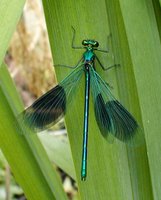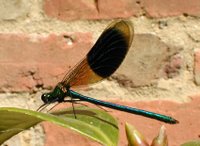Scientific Name: Calopteryx splendens.
English Name: Banded Demoiselle.
French Name: Le Caloptéryx éclatant (='the bright calopteryx').
 5 Key Characters:
5 Key Characters:
Habitat: Any open running water with a moderate current, from big rivers to streams and ditches, avoiding deep shade. Sometimes on particular fish ponds (étangs) and oxbow lakes if they are spring fed. The population peaks when the temperature is between 18 and 24 C. They can cope with light organic and chemical pollution. Males are territorial and spend their time defending a small patch suitable for egglaying, or sitting around on bankside vegetation, flicking their wings occasionally to signal their presence either to a female or to repulse a male. The females only come to water to mate and to lay eggs and are seen much less frequently than the males.
Flight Period: April-May-June-July-August-September-October-November. Flies slowly and flutteringly for a dragonfly (at about 16 wing beats per second, similar to many moths).
Status: Common and often numerous and conspicuous. Males with larger and/or darker wing marks are more territorial, more likely to be chosen by females and be healthier and less prone to parasitism. The species is not threatened at present, but pollution, the canalisation and unsympathetic maintenance of watercourses or the unchecked growth of woody vegetation on banks can all lead to local extinctions. Already the species is declining slightly everywhere due to water course 'improvements', modern agricultural practices and pollution.
Photographed by Loire Valley Nature:
Photographs are numbered from left to right and top to bottom. All photos enlarge in a new window if you click on them. 1 - 2 male. 3 - 12 males on bankside vegetation (Yellow Iris Iris pseudacorus) on the River Claise at Preuilly-sur-Claise, May.
English Name: Banded Demoiselle.
French Name: Le Caloptéryx éclatant (='the bright calopteryx').
 5 Key Characters:
5 Key Characters:- male wings have an opaque blue patch beginning at the node (halfway along the leading edge) and extending towards, but not reaching, the tip.
- male bodies metallic blue, female bodies metallic green.
- female wings faintly greeny gold tinted.
- the underneath of the last three abdominal segments on the male is yellow or greyish white.
- the pseudopterostigmas (a small opaque white rectangle on the leading edge) of the females wings are very close to the tips (the distance from the pseudopterostigma to the tip must be >4.5 and <6 times the distance from the node to the pseudopterostigma).
Habitat: Any open running water with a moderate current, from big rivers to streams and ditches, avoiding deep shade. Sometimes on particular fish ponds (étangs) and oxbow lakes if they are spring fed. The population peaks when the temperature is between 18 and 24 C. They can cope with light organic and chemical pollution. Males are territorial and spend their time defending a small patch suitable for egglaying, or sitting around on bankside vegetation, flicking their wings occasionally to signal their presence either to a female or to repulse a male. The females only come to water to mate and to lay eggs and are seen much less frequently than the males.
Flight Period: April-May-June-July-August-September-October-November. Flies slowly and flutteringly for a dragonfly (at about 16 wing beats per second, similar to many moths).
Status: Common and often numerous and conspicuous. Males with larger and/or darker wing marks are more territorial, more likely to be chosen by females and be healthier and less prone to parasitism. The species is not threatened at present, but pollution, the canalisation and unsympathetic maintenance of watercourses or the unchecked growth of woody vegetation on banks can all lead to local extinctions. Already the species is declining slightly everywhere due to water course 'improvements', modern agricultural practices and pollution.
Photographed by Loire Valley Nature:
Photographs are numbered from left to right and top to bottom. All photos enlarge in a new window if you click on them. 1 - 2 male. 3 - 12 males on bankside vegetation (Yellow Iris Iris pseudacorus) on the River Claise at Preuilly-sur-Claise, May.


















No comments:
Post a Comment